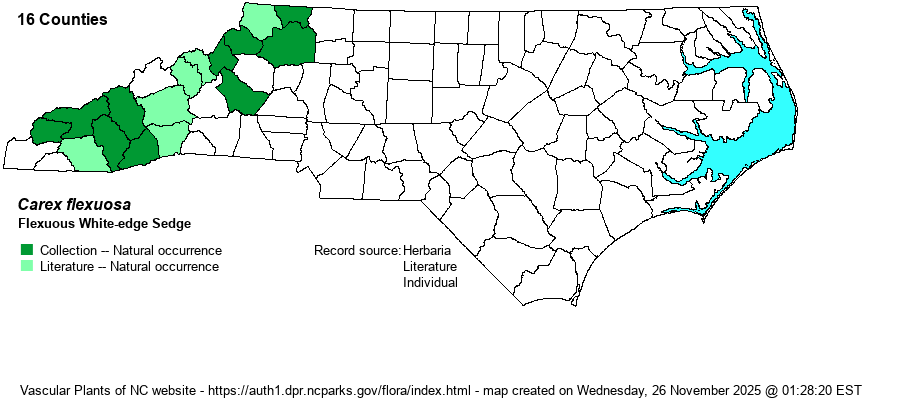| Section 5 » Family Cyperaceae |
Show/Hide Synonym
| taxonName | relationship | relatedTaxonName | relatedTaxonRefText | relComments |
|---|
|
|
|
|
| Carex flexuosa | = | Carex debilis var. rudgei | Radford, Ahles, and Bell (1968) | | | Carex flexuosa | = | Carex debilis var. rudgei | Gleason and Cronquist (1991) | | | Carex flexuosa | = | Carex debilis var. rudgei | Fernald (1950) | | | Carex flexuosa | = | Carex debilis var. rudgei | Gleason (1952) | | | Carex flexuosa | = | Carex debilis var. rudgei | Kartesz (1999) | | | Carex flexuosa | < | Carex debilis var. rudgei | Flora of North America (1993b, 1997, 2000, 2002a, 2002b, 2003a, 2004b, 2005, 2006a, 2006b, 2006c, 2007a, 2009, 2010) | | | Carex flexuosa | < | Carex debilis var. rudgei | | | | Carex flexuosa | < | Carex debilis | Godfrey and Wooten (1979, 1981) | | | Carex flexuosa | < | Carex debilis | Wofford (1989) | | | Source: Weakley's Flora |
|
| Author | Muhlenberg ex Willdenow | |
| Distribution | Mountains only, at moderate to high elevations. Only a few herbaria have annotated their specimens according to the recent splitup of C. debilis; additional counties will likely be documented.
Newf. to MN south to NC, TN, and MO. | |
| Abundance | Apparently uncommon, but owing to the uncertain taxonomy, with some or many specimens in herbaria perhaps still labeled as C. debilis of one taxon or another, the editors are not certain of the true abundance level. The NCNHP's State Rank of S3 is perhaps suitable. At the Bioblitz on Grandfather Mountain, 17 June 2023, it was a common species on trailsides above 5,000 feet. | |
| Habitat | Dry to moist, upland, mixed forests, openings, rock outcrops, trailsides. Habitats appear to be common and widespread in the Mountains, not specialized ones. | |
| Phenology | Flowering and fruiting May-July. | |
| Identification | Carex debilis and C. allegheniensis are closely related. C. flexuosa is distinguished from the other two by glabrous perigynia (pubescent in C. allegheniensis, glabrous in C. debilis) and perigynia 4.5-7 mm long (vs. 6-10 mm long in C. debilis). | |
| Taxonomic Comments | Carex flexuosa contains most plants formerly named C. debilis var. rudgei.
The genus Carex is the largest in North America, and among the largest in the world. In temperate and boreal regions, Carex is often the dominant or co-dominant ground layer in many habitats. Seeds (achenes) are valuable food for birds and small mammals, while foliage is used by birds and mammals to make nests and as food by mammals. Species of Carex often look vastly different from one another -- spikes erect vs. drooping, tiny inflorescence vs. whopping, culms leafy vs. naked, perigynia beaked vs. beakless, stems densely bunched vs. single, etc. The genus has been divided into many sections (or groups), based on shared characters; some taxonomists have suggested that these be different genera, but that proves unworkable (so far). All Carex share the feature of a perigynium (an outer covering) which completely surrounds the achene (seed). This covering may fit tightly or loosely (like a small bladder), depending on which group or species. Details of perigynia shape, ornamentation, presence and size of beak, number of striations (or veins) are all important ID features. In recent years Rob Naczi and colleagues have stressed the importance of arrangement of perigynia -- whether spiral (3+ ranks) or distichous (2-ranked) -- and have named a number of new species as well as split off some older synonyms. Therefore, RAB's (1968) key, excellent for its time, can only be used in a general way today. Members of some sections of Carex are difficult to key out (notably Ovales, Laxiflorae, Griseae); this is in part due to variation among individuals of a species, or failings of the key. FNA has drawings of most species and some species may be found in two or more places within a key, to acount for variability. New species to NC, and new to science(!), continue to be found in NC. | |
| Other Common Name(s) | None. This common name -- Flexuous White-edge Sedge -- forms a nested name with C. debilis, named simply as White-edge Sedge. The website editors do not like this name convention, and would prefer a different common name for C. flexuosa, but none seems available -- except for the also nested-name of Rudge's White-edge Sedge. | |
| State Rank | S3 | |
| Global Rank | G5T5 [G5] | |
| State Status | | |
| US Status | | |
| USACE-agcp | | |
| USACE-emp | | |

